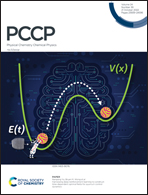Laser desorption/ionization on nanostructured silicon: morphology matters†
Abstract
The surface morphology of the silicon nanostructure plays a crucial role in the laser desorption/ionization (LDI) process. Understanding the correlation between the surface morphology and LDI performance is the foundation for creating silicon substrates with high LDI efficiency. Most of the present studies focus only on the structural parameters (such as porosity, depth, total surface area, dimension, etc.) of a single structure, but their effects on LDI efficiency vary with the types of silicon structures. Herein, two representative types of silicon nanostructures, porous silicon (PSi) and thorny silicon (TSi), were created to address this issue. The results indicate that the PSi substrate can generate a stronger heat effect and is beneficial to desorption; the TSi substrate can facilitate electron transfer and is favorable to ionization. Subsequently, the assertion was further confirmed by simultaneously detecting a dozen of standard samples and a real sample on both the TSi and PSi substrates, in which PSi can significantly enhance the detection signals of organic salts, whereas the TSi substrate can greatly increase the LDI efficiencies of neutral analytes. This finding provides a foundation for improving the LDI performance by tailoring silicon nanostructures, which is helpful for designing and creating substrates with high LDI performance.



 Please wait while we load your content...
Please wait while we load your content...